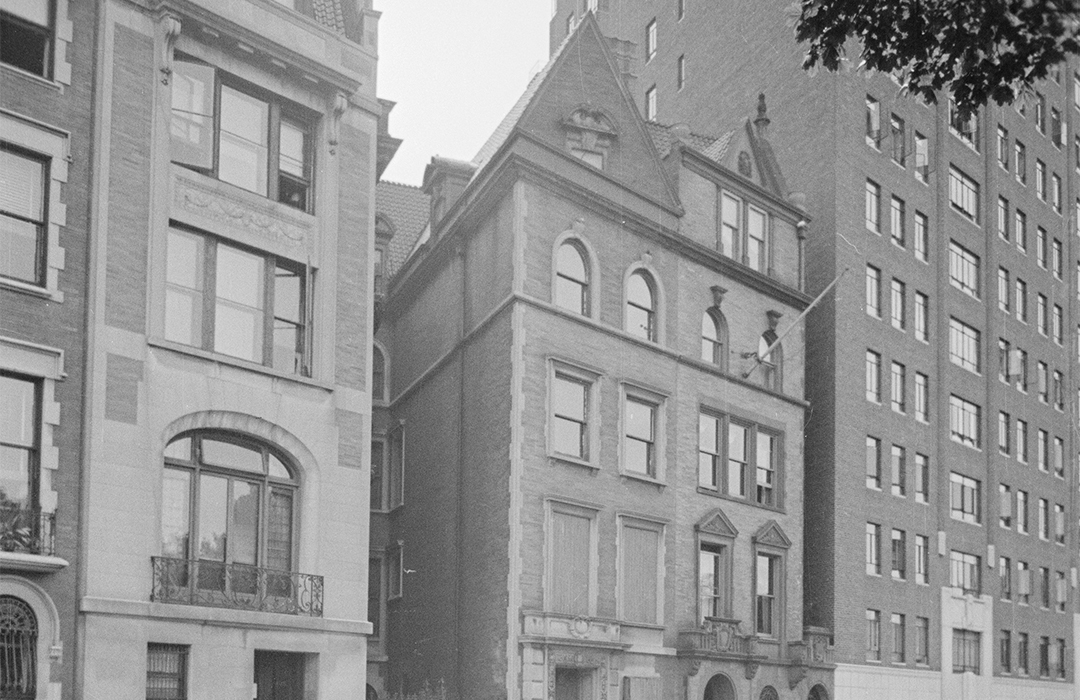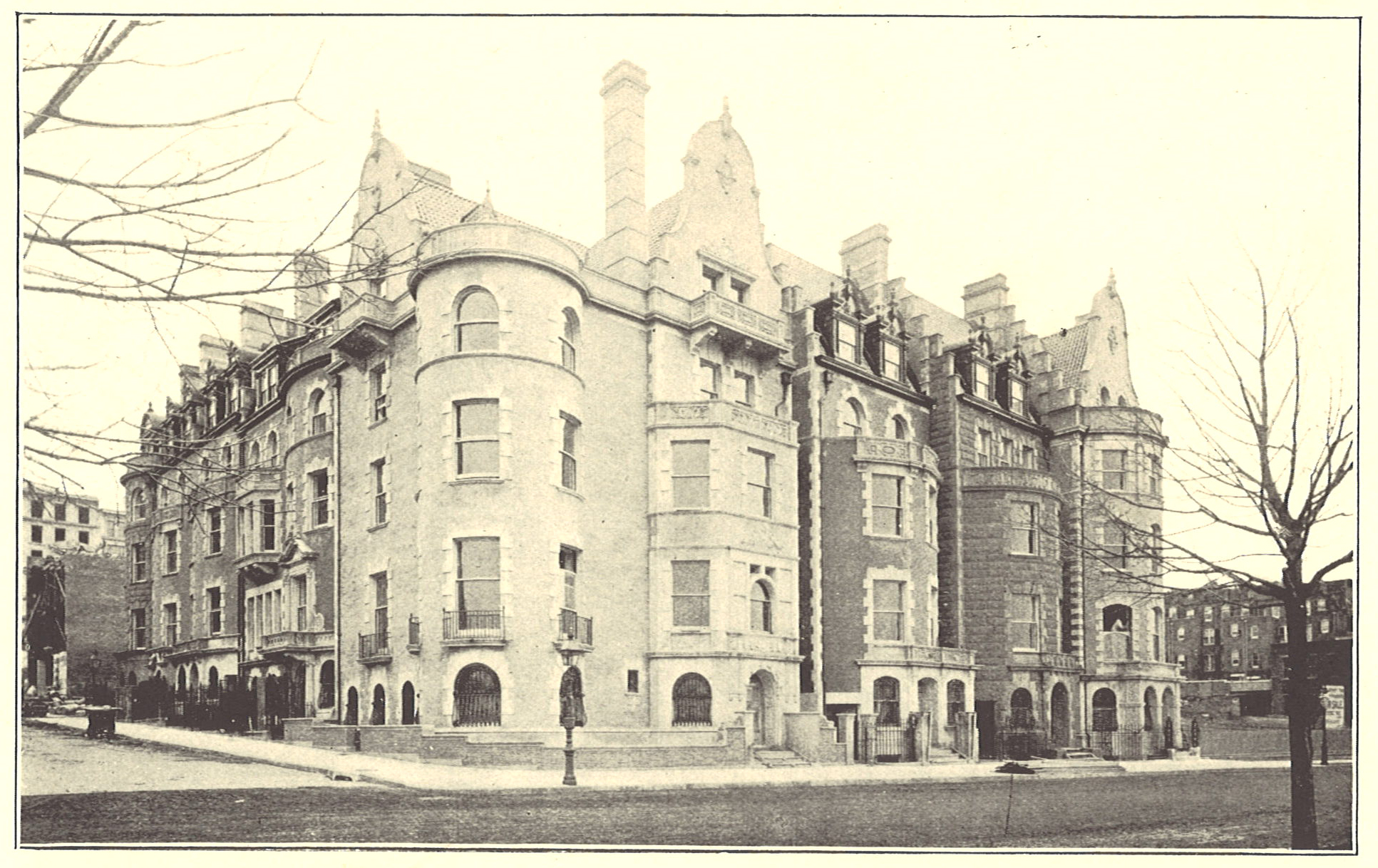
104 Riverside Drive
by Tom Miller
In 1898 architect and developer Clarence F. True broke ground for six upscale residences on Riverside Drive between 83rd and 84th Streets, with financial backing from popular actor Joseph Jefferson. Completed in 1899, each of the resultant Elizabethan Revival style houses had its unique personality, yet they flowed cohesively to create a picturesque row. Much of the charm resulted from their bowed fronts, which required the structures to lapse over the property lines. In 1898, before construction began, True received special, written permission from the Commissioner of Buildings to construct past the property boundaries, allowing for an undulation of bowed fronts and projecting porches.
Nos. 103 and 104 Riverside Drive were separated from their neighbors by deep light courts. True gave 104 Riverside Drive a fully rounded front façade that culminated turret-like in a “witch’s hat” conical roof, punctured by a single dormer with a dramatic pediment.
The house was purchased by Frederick William Winterburn and his wife, the former Emily Vreeland, in 1904. The couple had three daughters, Una Adele, Eva Marie, and Olive Emily. Their country estate Coprock was in Pocantico Hills, New York.
Born in England, Winterburn had been brought to America at the age of three. An architect, when he purchased the house he was superintendent of the architectural firm of Clinton & Russell. According to the Record & Guide, he was personally responsible for designing the Astor Hotel, the Mutual Life Insurance Company building on Nassau Street, and the Hudson Terminal, among other structures.
In 1898, before construction began, True received special, written permission from the Commissioner of Buildings to construct past the property boundaries, allowing for an undulation of bowed fronts and projecting porches.
Frederick Winterburn was involved in an untidy family dispute early in 1906. On Thanksgiving Day, his 40-year-old brother John A. Winterburn was committed to the Morris Plains Insane Asylum, “Doctors Ayres and Huger declaring him to be dangerously insane,” said The Sun. The newspaper noted that John was “worth about $50,000,” or about the equivalent of $1.68 million in 2023. Another doctor, named Mallon, diagnosed him as “a paranoiac, laboring under the delusion that he is a great magazine writer.”
Three months later, on February 26, 1907, Frederick faced his sister Amy Dana and brother in a courtroom where John’s sanity was again being examined. Amy declared, “My brother is as sane as any man and it is an outrage to keep him a prisoner in an insane asylum. I did sign a petition for an inquiry into his sanity, but I was deceived.” The Sun said only that Frederick, “believes his brother insane.”
As evidence that John A. Winterburn, the self-declared “great writer,” had lost his mind, Dr. Mallon allowed the jury to read a manuscript he had written. “The jury was convinced after reading the literature that he is insane and so declared,” said the article.
Trouble came to Riverside Drive after Charlotte Y. Ackerman purchased a lot just south of the True-designed houses. She went to court, alleging that the bowed bays that projected beyond the property lines interfered with her views and lowered her property values. Despite True’s written approval from the Commissioner of Buildings, the courts ruled in Ackerman’s favor, and the owners of the homes were ordered to remove the encumbrances.
Not surprisingly, Frederick W. Winterburn chose his own firm to make the substantial alterations (and one might assume that he handled the designs personally). The plans, filed on November 18, 1910, called for a “new front” to cost $3,000 (just over $96,000 today). Interestingly, the original doorway, bricks, and the limestone window surrounds were salvaged and reinstalled in the new flat façade. Even the quirky dormer was reused in the peaked gable where the witch’s hat had been.
The Riverside Drive residence was the scene of what The Sun described as “a large reception” following Olive Emily’s wedding on April 10, 1926. She was married to John Clendenin Burne in All Angels Church. The groom was with the Standard Oil Company.
Frederick and Emily were at Coprock on September 2, 1930, when the retired architect died. His funeral was held at Christ Church in Tarrytown, New York.
In June 1936, Goldman received what the New York Sun described as “P. T. Barnum’s mysterious clock, which runs without any apparent connection between its works and its single hand.”
It is unclear how long Emily remained at 104 Riverside Drive, but by 1936, it was home to conductor and composer Edwin Franko Goldman and his wife, the former Adelaide Maibrunn. Born in 1878, Goldman composed over 150 works and had founded the well-known New York Military Band in 1911, the name of which was later changed to the Goldman Band of New York. Goldman came from a musical family. His mother was a professional pianist, his uncle Sam Franco was a well-known violinist, and his uncle Nahan Franko was a nationally acclaimed concertmaster. Adelaide wrote the lyrics for several of Edwin’s songs, including “On the Mall.”
In June 1936, Goldman received what the New York Sun described as “P. T. Barnum’s mysterious clock, which runs without any apparent connection between its works and its single hand.” The article said, “Its secret must continue to keep as it has for almost a century. Mr. Goldman does not know how it runs, and either must stumble on the secret by accident himself or wait until his uncle, Sam Franko, the violinist, who gave it to him, decides to take him into his confidence. The clock has been the property of Mr. Franko for fifty-five years, given to him by his father, a New Orleans jeweler, who bought it from Barnum in 1880.”
The days of sprawling private houses along Riverside Drive were waning at the time. The former Winterburn house was converted to apartments in 1947, three per floor.
Tom Miller is a social historian and blogger at daytoninmanhattan.blogspot.com



